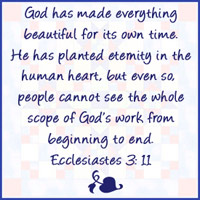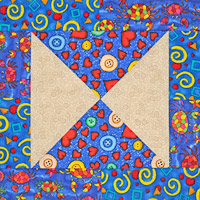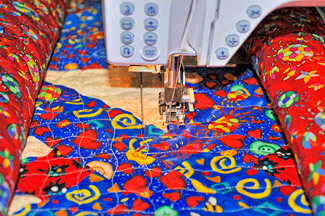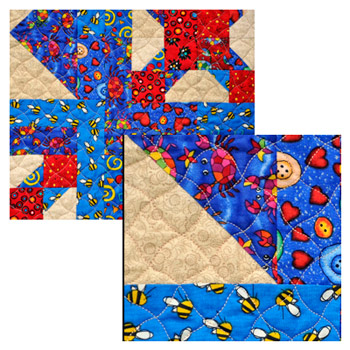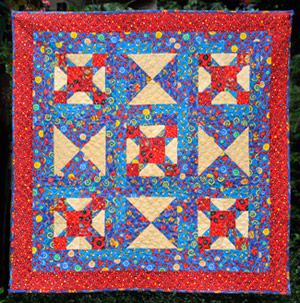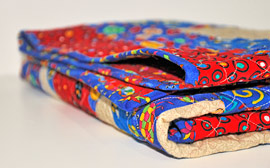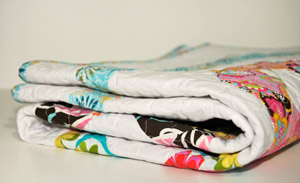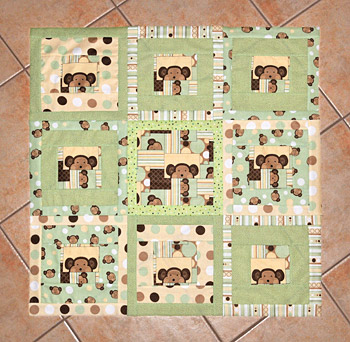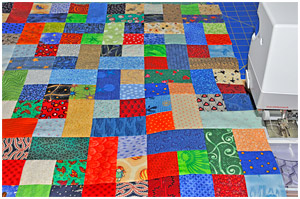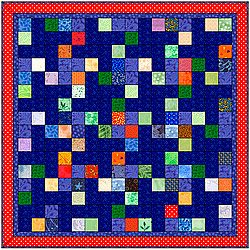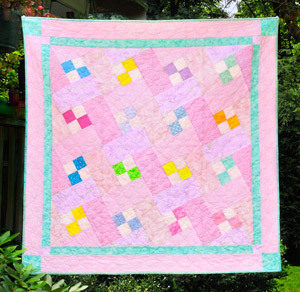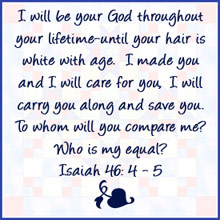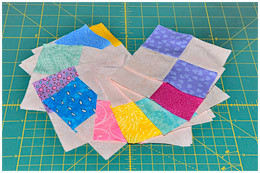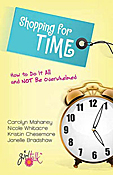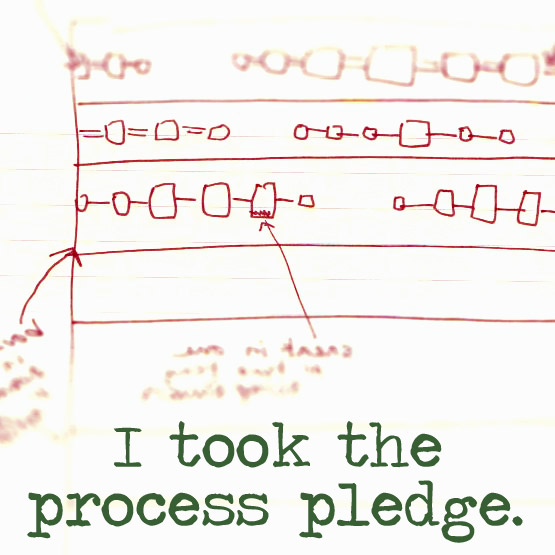
In part one of this tutorial, I demonstrated how to construct the Cheery Oh quilt block. It’s a very simple as well as fun quilt block to make. Although you could use print fabrics for the background units of the “O” shape, I really like the pristine appearance of solid white surrounding the focus points of these colorful blocks.
I made the design choice of setting the blocks on point. That means there is a need for setting triangles and corner triangles in order to complete the quilt top. If you’re new to the on point design setting for your quilt blocks, the diagram below may help. Of course, you can always choose a horizontal block setting and still produce a beautiful quilt with the Cheery Oh blocks.

Setting triangles (sometimes called side triangles) and corner triangles do add more complexity to the construction of a quilt, but setting blocks on point can really introduce variety to your quilt designs and produce increased visual interest.
Yes, there’s math involved unless you purchase a specialty ruler sold for this purpose. But it’s similar to doing the math for half-square and quarter-square triangles, with a little multiplication and division added. In fact, I prefer the math method for making setting triangles over the ruler method, but I’m getting ahead of myself. Grab your calculator for the following steps.
You will be using the calculation below to arrive at the size square you need to produce two corner triangles.
Formula for Corner Triangles
Size of finished block ÷ 1.414 + 0.875″
Round up the number this calculation gives you to the nearest 1/8″ (0.125) and cut a square this size. For example, my finished block measures 7 1/2″. 7.5 ÷ 1.414 = 5.304 + 0.875= 6.179. Rounding it up gives me 6.30 so I will cut my square about 6 3/8″.
Divide the square in half by cutting it diagonally, corner to corner. Repeat this step for the remaining two corner triangles needed. Rounding up is important because it adds a comfort zone to the size of the triangles, taking care of the rollover effect at the seam allowance.
If math is a scary thing for you, there are rulers on the market that simplify this step. I have the Diagonal Set Triangle Ruler by Marti Mitchell. I prefer it over the math method for corner triangles. You simply find the size marking on the edge of the ruler for your finished square and cut the triangles needed. It’s a handy tool not only for on point quilt settings but also for Square in a Square blocks.

Diagonal Set Triangle Ruler
Formula for Setting Triangles
Size of finished block × 1.414 + 1.25″
Round up the number this calculation gives you to the nearest 1/8″ (0.125) and cut a square this size. For example, 7.5 x 1.414 = 10.605 + 1.25 = 11.855. I rounded the number to 12″ for my square. In the case of these triangles, better a little larger than too small.

Cut Square for Setting Triangles
Now position a ruler diagonally from corner to corner and cut the square in half.

Cut Square in Half Diagonally
Without moving the two triangles, reposition the ruler diagonally at opposite corners and cut in half again.

Cut in Half Again
You now have four setting triangles. Repeat this step until you have as many triangles as your quilt top requires.

Four Setting Triangles
I mentioned earlier that I prefer the math method for this step. The ruler method is fine; you just cut one side of the triangle and then flip the ruler over to cut the other side. Personally, I find quartering the square easier. Which method you use is entirely up to you.
Now take all your blocks and triangles and place them in sewing order. I usually do this on my bed. You have a couple of choices to make at this point—sew the rows together diagonally or sew the four corner units and then sew the center blocks together. I like the second choice and that is how I constructed the quilt top.

Position Quilt Units in Sewing Order
Sewing the corner units together first for this particular quilt takes care of all the setting and corner triangles. I find the units of the quilt are easier to manage this way.
First, sew the two setting triangles to the corner block. Second, fold the corner triangle in half and finger press a small crease line at the center edge. Do the same with the block unit. Pin the corner unit to the block unit at the center point, right sides together.

Crease and Pin Center
It’s now easy to sew the corner triangle to the block unit with it perfectly centered.

Sewing the Corner Triangle to Corner Unit
After you’ve constructed all four corner units, begin sewing the center quilt blocks together in groups of three. Match up and pin each of the seam intersections. Next, sew the three rows together in the same manner.

Sew Blocks in Groups of Three
Position all of the sewn quilt units in order. Sew each corner unit to the center quilt block unit, pinning at seam intersection.

Sew Corner Units to Quilt Top
You now have the main section of your quilt top completed. Notice the secondary square and diamond shapes that the on point design has produced. I love this setting!

If you’ve never attempted to place your quilt blocks on point, I hope you’ll take a deep breath and give it a try. Like so many first-time experiences, you’ll feel a little unsure of yourself as you‘re cutting all those triangles, but soon you’ll be right at home with the process.
I’m now ready to work on the quilt borders so off I go.
Happy quilt designing,
Nancy
Read Full Post »
